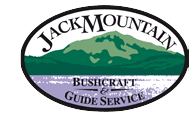What can Jack Mountain Bushcraft School teach us about authentic marketing?
A relevant education in today’s changing world
What skills come to mind when you think of the phrase “necessary education?” Basic literacy and math? Computer science? STEM-related curriculum? It won’t be too long before some of the older “necessary education” skills become irrelevant. Think about it this way: When did you learn to balance a checkbook by hand? This skill is outdated in our digitized world of online banking. There are many essential elements of any 21st-century curriculum, from STEM to digital literacy. But when life gets rough, when the chips are down, does this focus on developing the skills of a digital native encourage relevant skills? Imagine a person you know who is truly confident. Someone who can handle just about any situation. It almost seems like this confidence doesn’t stem from anything material or tangible; it comes from who they are. And what about our kids?
I spend plenty of nights thinking, “How can I help my son grow up to be a well-rounded person? What will help give him the skills to not only ‘handle’ challenges, but rise to meet them?”
This sounds to me like a need for a return to nature. A “back to basics” education that will give him the skills and strategies to dominate his environment, to cherish, respect, protect, and live with and by nature.
Enter: Jack Mountain Bushcraft School.
Famous Arctic explorer Vilhjalmur Stefansson once wrote, “Adventure is a sign of incompetence.” But you see, he’s not challenging the nature of the term ‘adventure’ with a negative connotation.
“It implies that you’re not prepared for what you face, which, in the case of living a life outdoors, should never be the case.” – Tim Smith, founder of Jack Mountain Bushcraft School
Think of it this way: With a full pack of life-saving resources, a detailed route, emergency rations in place, and a plan of action, you’re not truly experiencing ‘adventure’. So rather than taking an uncalculated risk and venturing off on an ‘adventure’, plan your course, exercise emergency precautions, and take calculated risks. And you might just survive. Sounds kind of like life, doesn’t it? A journey that, when paired with excellent preparation and a calm, collected head, doesn’t sound all that scary. How I want that for myself and for everyone that I love. Because, and think about it, when do people feel upset or confused? When they get caught by surprise and lack the skills to overcome a crisis. But when you do have these skills, it means you have confidence and competence. You are prepared for change, for adversity, you are ready to take on a complex world. A great way to develop this? Build experience through experiential education.
Let’s try an example: It’s easy to scoff at friction fire since matches and lighters are so readily available. But remove this new technology from the equation, and the action of starting a fire with flint and steel becomes instantly relevant. The desire to learn the subtleties of the hand drill takes on renewed importance. Our students are actively learning, immersing themselves in a curriculum borne out of necessity and relevance. A prime instance of experiential education.
An example of this is how Jack Mountain Bushcraft School teaches shelter building. You can learn something about a shelter by making one. You can learn more about it by spending the night in it. But to truly know that specific shelter, you need to spend four consecutive nights in it. In this way, you’re forced to deal with the consequences of shoddy construction or a lack of attention to detail. Keep in mind, in case it is not immediately clear, that I am going on and on about shelters, but this applies to most of the timeless skills we should teach our children! Maybe the first night is rough, but it teaches you what you need to do before the second night in order to shore it up and get some sleep. The second night is spent learning some of the subtleties that would make it more comfortable. The third night is fine-tuning it to your specifications, and the fourth? Enjoying the fruits of your labor. If you were to build the same shelter again, you could eliminate the learning curve because you’d know what to do from the outset. That’s experiential education. This is the attitude Tim Smith works to instill in his programs.
Authentic Marketing: The Little-Known Way to Grow a School

Tim Smith, with over a year’s experience surviving the harsh Alaskan wilderness, knows a thing or two about hard work. The lessons he learned about surviving the elements literally create the content and structure he uses to share his vision with the world. He identified a need to bring outdoor education back into the lives of future generations. The benefits of spending time in nature?
- Kids who walk just 20 minutes outside every day have 25% fewer colds than those who don’t.
- Walking outside helps inspire creativity.
- It can significantly decrease symptoms of ADD and ADHD
- It teaches responsibility.
- And it can even reduce stress, evoking emotions of productivity, accomplishment, contentment, satisfaction, and elation.
In this, Tim Smith recognizes the difference between marketing and advertising. “But wait,” you may be thinking. “Aren’t marketing and advertising the same thing?” Well, that’s why we’re here. Marketing, in effect, is all about designing a brand you believe in, embodying an identity of progress and student success. Advertising? That’s only a small aspect of this bigger picture. Yes, advertising is about getting the word out to prospective students, converting interested families to future enrollment. Tim Smith has found this “sweet spot” right in the middle: honing in on a specific target audience and building a brand around that identity. Because of this, enrollment has been consistent for years, and he doesn’t have to waste his time rebranding. So what does he do to set the bar for online marketing?
“Step 1: Perfect your unique brand. Step 2: Find a niche target audience. Step 3: Start thinking about advertising spending.
Always in this order, never in reverse.”
The school maintains an online presence through a website, a blog, and a social media identity. Rather than apply some “flashy” artifacts or capture superficial moments, Tim prefers to simply shine a light on their program:
“We just post a photo and a caption to give the viewers an idea of what we’re doing on a daily basis.” – Tim Smith
That’s it. Nothing more than shining a light on their daily lifestyle and giving followers and viewers a taste of day-to-day living. Any survivalist will tell you that panic and fear are two of the biggest killers in the wild.
Backcountry Attitude says it best: “A positive mental attitude is still the best remedy. To combat fear and panic, keep your cool, relax, see the brighter side of things, and stay in control.”
What lesson did Tim Smith pull from this sage advice? Tackle one problem at a time, keep a level head, and maintain your cool. He applied this same tactic to his social media strategy: Identify one specific target at a time and attack it with everything you’ve got.
“Put yourself in the mindset of your potential clients and build your web properties around what they might be looking for.” – Tim Smith
When you cover one basic need at a time, you build a foundation and reach a potential family with the strongest possible case for enrollment. And the results of his hard work and constant dedication? A profitable business. But profit isn’t his only goal.
“I think the purpose of the Jack Mountain Bushcraft School is to provide educational opportunities and experiences unavailable anywhere else. When we do it well, we make a profit. But profit is the result, not the purpose.” – Tim Smith
Lessons Learned
“There are so many ways the world is moving toward automaticity. Yet nothing could ever replace authentic experience and personal passion.”
Tim Smith has found a way to share his passion and experiences with the world. He chooses to forgo traditional education and provide a more genuine learning experience. In the words of Ernest Hemingway, a survivalist and author, “All you have to do is write one true sentence. Write the truest sentence that you know.”
The Jack Mountain Bushcraft School has found a way to do just that.
